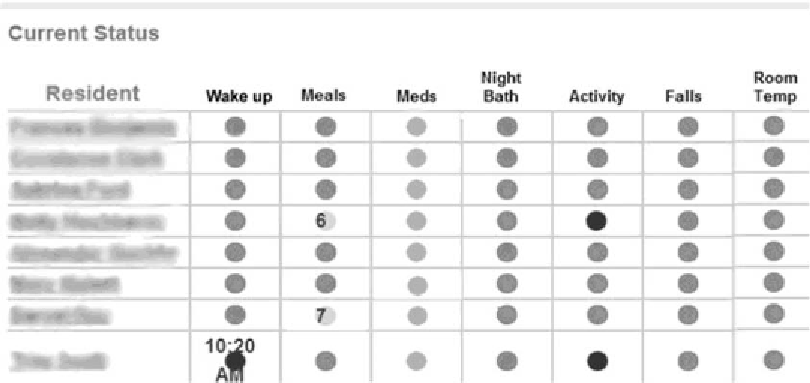Information Technology Reference
In-Depth Information
Figure 1.
Stage 1: Daily Living Suite
and drawer in the kitchen was monitored. Also,
multiple motion detectors were placed throughout
the living/dining room, bedroom, bathroom and
kitchen. The result of this was that much of the
data proved to be redundant and that the large
amount of data actually confused us and concealed
important patterns. Consequently, sensors were
turned off in a systematic way until we were able
to accurately “observe” the task oriented behavior
with the use of the smallest number of sensors
(Glascock & Kutzik, 2004).
ELMS was installed in an activity of daily liv-
ing suite comprised of a one bedroom apartment
with a full kitchen, bedroom, living/dining area
and bathroom at a large regional hospital. Elderly
patients spent the night in the suite in order to be
assessed as to their ability to function indepen-
dently. ELMS, along with a video camera, was
installed in the suite to record activity during the
overnight stays. The two most illustrative findings
were: first, do not place sensors near heating and
air conditioning vents; and second, less is often
more. Because it appeared to be the best location
to record movement between the bedroom and
bathroom, a sensor was initially placed within 12
inches of a heating and air conditioner vent. The
result was real noise as approximately every 15-
20 minutes there was a flurry of activity recorded
which appeared to indicate that the individual
being monitored entered and left the bathroom
repeatedly. Review of the video tape indicated
no such activity and eventually it was determined
that it was the air coming from the vent that trig-
gered the sensor.
Initially, every appliance—microwave, dish-
washer, stove, television—and every cabinet
Stage 2: Sequential Installations
In this phase of testing ELMS was installed
sequentially into the homes of volunteers. The
installations ranged from one to three months and
during this period, volunteers were interviewed
on a regular basis to determine the validity of the
recorded activities and the acceptability of the
system. Perhaps the most important finding was
that holidays and weekends changed people's ac-
tivity pattern. In our first installation, we observed
what appeared to be aberrant behavior for a single
Thursday after three weeks of consistent activ-
ity. After pondering whether this was a problem
with the hardware or software, or whether ELMS

Search WWH ::

Custom Search